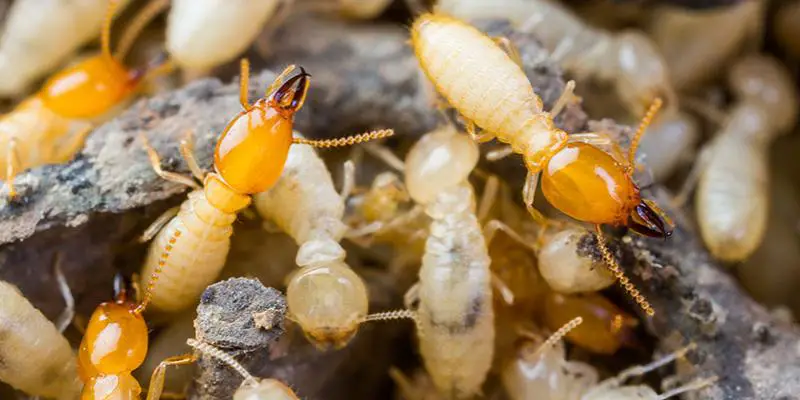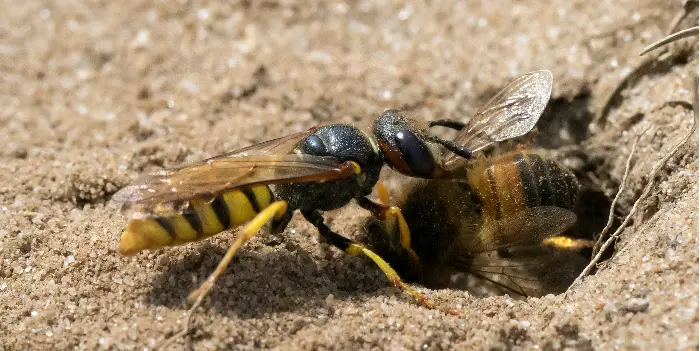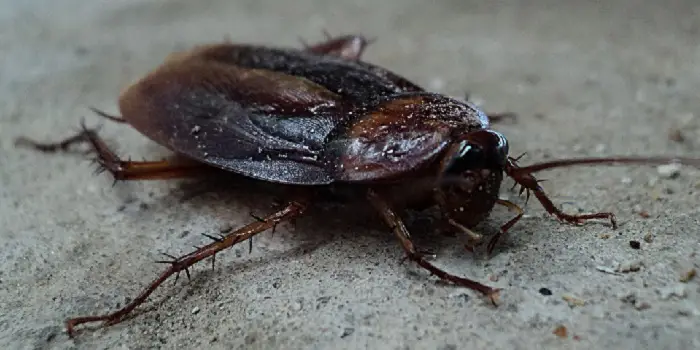
Cockroaches are not desirable in the home.
We understand that the last thing people want to see in their living rooms is roaches crawling lazily across the floor.
Fortunately, many different bugs only look like roaches.
But they are not!
Indeed, the roach that was scuttling through the kitchen might be one of six common bug species that are very similar to cockroaches.
But before we get into those bug details, let’s check out what roaches look like.
How to Identify Roaches?
If you want to find out what cockroaches look like, let me tell you, their look will mostly depend on their species.
It may come as a surprise, but four major indoor roaches species reside in your homes in the United States.
Let us check out the characteristics of each species…
a) German cockroach:
When you make a rough picture of a cockroach, you are likely to think of this typical yellowish-brown bugger.
They range in size from ½ inch to 5/8 of an inch in length.
You can identify a German roach by the two parallel bands which go from these pests’ heads back down to their alluring wings.
b) American cockroach:
These critters are big and glossy. They may be around 2-inches in length.
The color is of grave importance when you talk about identifying these cockroaches.
They are red-brown in color with soft amber streaks.
They have wing covers but they like to munch your food more than fly.
c) Oriental cockroach:
Because of their smooth and lustrous dark brown body, this cockroach type is also called “black beetle cockroach” or “shad roach.”
They grow around one ¼ inch in length.
Their color is their primary distinctive spec as they are mostly almost black.
d) Brown-banded cockroach:
These house intruders are the smallest roach breed.
They are light brown in color, winged and trim. They can sometimes be confused with German cockroaches.
But you can differentiate them based on the two subtle haphazard lines on the wings of the brown-banded cockroaches, while the German roaches feature dark lines behind their heads.
Roaches, in general, desire to have meals with you, bath with you, enjoy during parties, and sometimes even sleep with you in your bed.
If you didn’t like their aim, then you should focus on identifying the type of roach that has shown the courage to enter your house.
Once you find it out, you can take steps to free your house or office from these pathetic critters.
Bugs that Look Like Cockroaches
I’ve compiled a list of bugs that could all possibly be the culprits moving about your home, to help you rule out the possibilities.
Let’s check more about these mistaken ones and know how these are different from common kitchen roaches.
1- Beetles

There are hundreds of thousands of beetle species in the world, and as such, a few of them happen to look like roaches.
The June bug, for example, is squatter and wider than the average cockroach, but with a quick glance, they can look immensely similar.
And the June bug (also called June beetle and May beetle) isn’t even the only beetle species that looks like a cockroach.
It is one of many that can do the job of knowing what is difficult.
The Basic Differences
Cockroaches do not have wing cases, and beetles do.
This is one of the first things to look for when you see a bug in your home.
A beetle will often not have exposed wings. They tuck them neatly into their bodies, under their external skeleton.
Cockroaches are just the opposite, leaving their wings resting outside of their bodies.
Then, of course, there are the more obvious attributes. Cockroaches have longer legs and antennae than beetles.
As said earlier, beetles are squatter and wider, whereas cockroaches are longer.
When in doubt, if the bug is long and skinny, it might be a cockroach.
Beetle Types and Comparisons
Then there are ground beetles which are numerous. Ground beetles and oriental cockroaches look very similar.
While there are many ground beetles that are not look-alikes at all, because they have different colored exteriors, many of the dark ones look like oriental cockroaches to a large degree.
The biggest difference is that oriental roaches have larger heads.
These bugs will be found outside, on underwood and rocks, or in more damp areas.
As mentioned above, yet another beetle that looks like a cockroach is the June bug.
The bug is attracted to light and feeds on plants. This is a sign that it is a beetle, not a cockroach.
Indeed, the beetle is also darker, and rounder than cockroaches are.
Again, the squatter bugs are likely to be beetles. There is another thing that should be mentioned, however; beetles like to live in nature.
It is less likely that they will choose to live indoors, which is another fact that should be taken into account.
Cockroaches like the dark and so tend to live inside more often.
Overall, it can be tricky to tell a cockroach apart from some of the different kinds of beetles.
Luckily, the typical beetle behavior is one of the giveaways.
Beetles will often be more active and spend time in wider, brighter outdoor spaces.
They are also squatter and wider. Make sure to consider these things when you are trying to tell a roach apart from a beetle.
2- Water Bugs
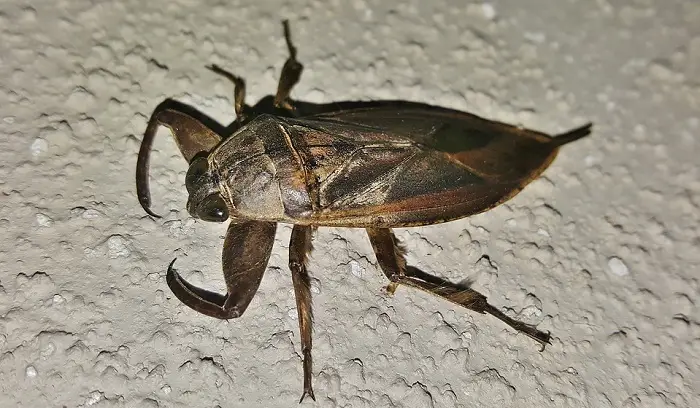
Water bugs, also known as toe-biters, are often thought of as many different species.
The oriental cockroach mentioned earlier, for example, is often called a water bug even though it cannot live in the water.
Real water bugs live near or in water where cockroaches prefer only damp areas.
There are many other insects that are titled ‘water bug’, and there are many things that set the natural water bug apart from the imposters.
It can be hard to tell what is what, so here are some things to keep in mind about water bugs and cockroaches.
A water bug differs from a cockroach in a few important ways.
First of all, despite the fact that both are relatively the same size, the water bug does not have, nor does it need antennae.
In addition, much like beetles, the water bug likes to live near light.
This leads to another key difference. Cockroaches are prone to minding their own business and inhabiting inhospitable areas.
The water bug, however, is a predator. A bite can cause severe damage due to the fact that its enzymes can disturb areas in humans.
The water bug has large pincers on the front of its body, which also help set it apart from the cockroach.
Overall, they are more active and open than cockroaches are.
Now you know the difference between a cockroach and a water bug and what to look out for.
And honestly, as annoying as cockroaches are to get rid of, at least they don’t attack things like water bugs too.
In the end, if either of these things is in your home, you’ll want to get them out as soon as possible.
3- Palmetto Bugs
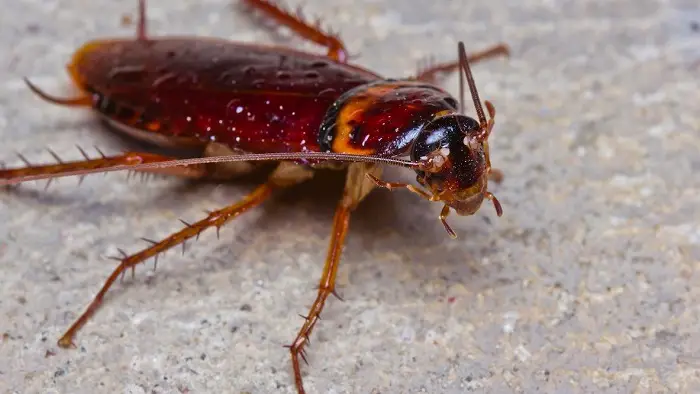
So far, the bugs on this list have been entirely different from the American cockroach, and there is no reason to think anything different about the palmetto bug.
Only, the palmetto bug isn’t different from the cockroach.
They are, in fact, the same thing. The palmetto bug is a species of cockroach from Florida that enjoys hiding under leaves.
The name then spread to many other kinds of cockroaches.
Largely, the ‘palmetto bug’ became popular because people didn’t want to admit that they had roaches in their homes.
Fortunately for them, the difference went unnoticed, and to this day, many people believe the palmetto bug and the common cockroach are entirely separate insects.
They aren’t, but the name stuck.
Because the American cockroach is the most common roach, it is the one most often called the palmetto bug.
As listed above, people also call it a water bug as well, in addition to some other nicknames, such as the ‘southern cockroach’ that have stuck over the years.
4- Bed Bugs

It can be almost impossible to tell bed bugs apart from baby cockroaches without catching one to get a closer look.
They are both roughly the same size and color, with very few differences.
The baby cockroach is a slightly lighter color, with slightly formed stripes from its exoskeleton.
In addition, just like beetles, the bed bug is squatter and rounder than the baby cockroach.
This would be almost impossible to see unless both of the species could be compared with one another, but it is true nonetheless.
Finally, bed bugs have longer antennae than baby roaches do.
5- Termites

The difference in size between termites and cockroaches is not as prevalent as the difference in behavior.
The average termite, even though there are roughly forty species, likes to be in groups.
They have monarchs of their colonies, a king and queen, and gather in large groups. It is rare to find a singular termite.
This is not the case with cockroaches.
Cockroaches are not so prone to living in groups and are bigger than termites are.
In addition, termites are darker, hardened creatures.
Where termites almost look see-through, cockroaches look nearly black, except for the albino cockroach.
Another thing that separates termites from cockroaches is that they live in different areas.
Termites don’t care as much about water sources or food.
They like to live secluded in walls and tight spaces, and they only take to eating wood and wood products.
Cockroaches, however, are often found in kitchens and places with food and moisture where they can easily find things to eat.
6- Crickets

Crickets are not commonly found in the home, given that they are not suited to indoor environments.
Crickets are a dark color, black or brown, and they are much more prone to jumping than scuttling.
This is perhaps the most significant difference between cockroaches and crickets.
Crickets have large back legs that they utilize to chirp and jump.
Often, it should be clear that whatever in the home is either a cockroach or a cricket.
Crickets will chirp and jump, and roaches will do just the opposite.
Keep that in mind when trying to figure out what insect is lurking about your house.
Out of the three necessities of life, animals, insects, or pests need only two – food and shelter.
So, the cockroaches, or any other bugs for that matter, choose your home as they get their source of food, water in plenty, plus a perfect hideout.
You are not voluntarily providing them food, but your activities make it a safe –haven for them, namely:
- Unclean dishes with leftover food pieces in the sink
- Bread crumbs or pet foods spilled on the floor
- Leaky pipes and water-line
- Open food containers are thrown into the garbage
How to Get Rid of Roaches and Bugs in Your home?
Even though the above-mentioned points are only a source of attraction, you have to look at how they can get into your home.
Roaches and small bugs can easily sneak in, even if there is a small vent or hole.
They hide under holes in the sink or crevices or water-outlet area in the bathroom.
So, you will need to check for ideas to prevent cockroaches from entering your home.
1) Clutter-free area
When so many things lie here and there, roaches will find it easy to move from one to another and hide easily.
Even if you spot them, they will easily escape from your eyes in a moment before you get hold of your broomstick or shoes.
When you keep your home clean and clutter-free, cockroaches will be devoid of space to hide fast. This gives you a chance to kill them easily.
Newspapers and cardboards also offer a perfect space for cockroaches to breed and thrive.
So, make it a habit to dispose of the old newspapers and cardboard then and there. Don’t let it pile up.
2) Give no space to let them in
Cockroaches usually tend to gain entry through the small cracks in the walls or holes in the sink and the gap between the door and the floor.
- To address the gaps in doors, fit door sweeps.
- For drainage locations, you can use closely knitted wire mesh in such a way that it blocks access to cockroaches.
If you cannot detect these spots, you can hire a professional who is well-versed in this job.
It is also advisable to keep an eye on these vulnerable areas once in a while to see if there are any loopholes for easy access.
3) Clear the left-over food immediately
Feeding your pets for their good health is your duty.
You have to make sure they eat entirely without any spillover and there is no leftover food.
In case of any leftover food, put it in the dustbin by covering it properly.
4) Seal the leakages and fix plumbing issues
Many of you would not have the habit of fixing issues as soon as it crops up in your household.
One of the main issues is water leakage in taps or pipelines.
You may not initially pay much attention to sealing it, as you see only a few drops of water falling every hour.
But you are not aware that this continuous moisture is a welcome party for the cockroaches as they need water to survive and keep themselves cool.
So, you must fix these plumbing problems in the initial stage itself without dragging them.
5) Clean your home daily
Bugs, insects, and cockroaches are always attracted to dust and dirt.
The best solution is to keep your dwelling area neat and clean without leaving any scope for cockroaches to thrive in your home.
Like they say, “A stitch in time saves nine” most of the things you need to do is to address the problem in the initial stages itself without letting it grow further.
- Mop your home daily
- Wash dishes after every meal
- Clear the spillovers and crumbs as soon as you see them
Tasks like these may seem small, but their effects are monumental.
Only those who have experienced problems in dealing with cockroaches will realize the importance of it.
6) Sticky or Glue Traps
These sticky or glue traps have proven effective in getting rid of rats, lizards, and other bugs.
This will be an effective solution in getting rid of cockroaches too.
All you have to do is open the trap and put a bait which attracts the cockroach towards the trap.
Once the roach steps into the trap in search of the bait, their feet will get glued to it, and they will not be able to move further and get trapped finally.
You can keep this open trap overnight or for a few days till all the cockroaches get caught.
7) Boric Acid
Boric Acid is another excellent home remedy and is readily available.
Take an equal proportion of boric acid, sugar, and flour and make a dough using them.
Keep these dough balls in areas where cockroaches roam, often under the fridge, sink, etc.
The cockroaches will eat these dough balls due to the sweet flour taste, and when the boric acid gets ingested, it will eventually kill them.
These dead cockroaches will become food for other cockroaches.
Remember, if you have pets at home, using this hack is not advisable; it will prove fatal to your pets as they would like to eat these dough balls as well.
So, exercise caution while using this technique to get rid of cockroaches.
8) Cucumbers
Cucumbers, known for their moisturizing and hydrating properties, can be used to keep the roaches at bay as they are wary of the smell of it.
Keep a few slices of cucumbers around the entrance point of cockroaches, and you can see them backing off after sniffing them.
9) Cinnamon Powder
The spicy nature of cinnamon gives chills to the cockroaches as they don’t like the strong scent of it.
This keeps them at bay without letting them get inside the kitchen cupboards.
All you have to do is sprinkle some fresh cinnamon powder around the cupboard borders.
This reduces cockroach activity to a great extent. If you find this working well, you can replace the powder once every few days.
10) Chemical Baits
This is similar to the concept of using Boric Acid, which we have already discussed.
You can get these chemical baits from the departmental stores and keep them near the cockroaches’ area.
These baits may seem like a food source but are full of poison.
Once the cockroaches consume and return to their hide-out, they eventually die and spread this poison to other cockroaches in the group, finally resulting in mass extinction.
11) Liquid Concentrates
You can buy specially made cockroach repellent liquid concentrates from the stores.
Mix water to dilute these concentrates and spray it on areas where the cockroaches usually hide, like holes or vents.
This solution can mop floors, wipe kitchen slabs, etc.
Also, there are a variety of other ways by which you can prepare DIY homemade concentrates at home to repel bugs and roaches. Some of them include:
a. White Vinegar and Hot Water
In this hack, you need only two simple things, namely, white vinegar and hot water.
Mix one tablespoon of white vinegar with hot water and use this solution for wiping the kitchen slabs and cabinets, and also, you can pour the excess into the sink drain.
This will give hesitation to the cockroaches to climb, and this acts as a good disinfectant.
b. Lemon, Baking Soda, and Hot Water
Lemon and baking soda combinations are used for various purposes, and one such purpose is using it to keep irritating cockroaches at bay.
Mix 1 tablespoon of lemon with two tablespoons of baking soda in hot water of 1 liter and mix it well.
To prevent further breeding of cockroaches and a complete washout of their encroachment, pour it in the drain.
c. Use of Essential Oils
Essential oils are not only a part of your skin-care maintenance or healing routine, but they can be used as the best alternative to keep these bugs at bay.
The aroma of oils like peppermint and lavender is a big no to cockroaches, and they will hesitate to live further in that area.
The aroma of essential oils can give a good fragrance to your kitchen, lifting your mood while cooking.
d. Extracts of Neem
Not only is Neem known for its medicinal properties to heal but it also assists in warding off these cockroaches and other bugs.
Put some Neem leaves around the corners of the kitchen walls. You can also make a mixture of neem oil with warm water.
The above mixture can be sprayed in various areas where you feel the roaches come quite often. This will deter them from coming further.
The Conclusion
Pest control services provide numerous solutions to household problems.
The issue is that most of the services are specific to the type of insect or creature that needs to be removed.
Therefore, to ensure your house is getting the treatment it needs, it is best to properly identify the critters that are inhabiting it.
Cockroaches are capable of spreading disease and should be removed whenever possible.
Unfortunately, so many bugs resemble cockroaches that it can be hard to figure out what creature is what.
Luckily, there are simple things that, when learned, can help you determine the bugs in your house.
It isn’t the most glamorous activity, learning about insects, but neither is having them in the home.
By doing the extra work, you can be prepared to deal with an insect situation whenever it arises!
Share the post "What House Bugs Look Like Roaches – But Aren’t"

Welcome to ProShieldPest.com. I am Tina Jones. I have been working as a pest removal professional in Winslow, Arizona lately. At present, I love to spend my time with my family as a retiree.
Here I share all my knowledge and experiences to help people understand better how they can stop pests at their homes without actually killing them. Hopefully, the information you will find here will help in safeguarding your home! You can check more about me here.

